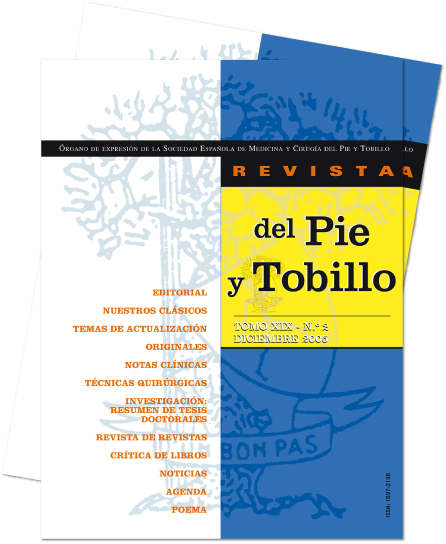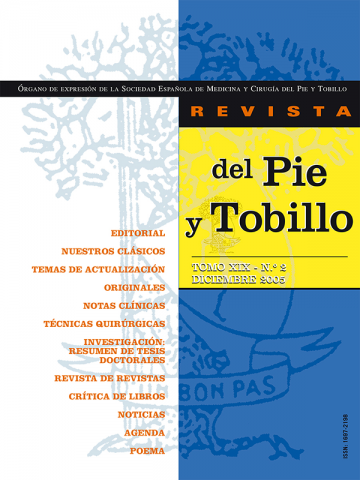(sin asignar)
Recibido: 7 de junio de 2005
Aceptado: diciembre de 2005
Artículo / Investigación
Ángulo articular distal del primer metatarsiano. Estudio de fiabilidad de su registro, y de su variabilidad intra- e interobservador
Distal first metatarsal articular angle. A reliability study of its recording and of the inter- and intra-observer variability
Rev Pie Tobillo. 2005;19(2):149-53
Comparte este contenido
En esta edición
- Lesiones osteocondrales del astrágalo. Técnicas quirúrgicas por cirugía abierta
- Evaluación clínica y radiológica de las técnicas quirúrgicas Chevron y percutánea en la corrección de hallux valgus... un año después
- Bloqueo del nervio ciático para cirugía de hallux valgus en régimen ambulatorio
- Cirugía del antepié en régimen ambulatorio
- Validación clínica en nuestro medio de las reglas del tobillo de Ottawa
- Neurilemoma gigante no invasivo de 9 años de evolución localizado en el nervio tibial posterior
- Hallux flexus: nota de técnica quirúrgica. A propósito de dos casos
- Técnica Primer Meta Stop en la cirugía del hallux valgus
- Ángulo articular distal del primer metatarsiano. Estudio de fiabilidad de su registro, y de su variabilidad intra- e interobservador
- Revista de revistas
- Biomecánica clínica de los tejidos y las articulaciones del aparato locomotor
- XXVII Congreso Nacional de la AEMCP
- Agenda
- Don't let it be
- Calzado del corredor
Más en PUBMED
Más en Google Scholar


Revista del pie y tobillo está distribuida bajo una licencia de Creative Commons Reconocimiento-NoComercial-SinObraDerivada 4.0 Internacional.



